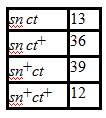In calculating the partial correlation between two variables holding one other variable constant, how many sets of residuals will be created?
A. 1
B. 2
C. 3
D. None of the answers is correct.
Answer: B
You might also like to view...
Evolution _____________. (Mark true (t) or false (f) for each statement.)
____ is a change in allele or genotype frequency over time ____ always results in a visible change in the physical characteristics of an organism ____ is a process that takes many, many generations ____ is only seen in unicellular organisms ____ is a natural phenomenon that is outside the influence of humans ____ can only occur in the natural environment ____ is not seen in domesticated animals ____ always results in an increase in an organism's fitness ____ is inherently random in nature ____ acts on animals but not plants What will be an ideal response?
Which organism may be implicated in arteriosclerosis?
A. Escherichia coli B. Pseudomonas aeruginosa C. Staphylococcus aureus D. Chlamydia pneumoniae
What is the map distance between sn and ct?
In Drosophila, singed bristles (sn) and cut wings (ct) are both caused by recessive, X-linked alleles. The wild-type alleles (sn+ and ct+) are responsible for straight bristles and intact wings, respectively. A female homozygous for sn and ct+ is crossed to a sn+ct male. The F1 flies are interbred. The F2 males are distributed as follows:

A) 12 m.u.
B) 13 m.u.
C) 25 m.u.
D) 50 m.u.
E) 75 m.u.
In the light-dependent reactions of
photosynthesis, how do hydrogen ions get back into the stroma?
a. passive diffusion directly across the thylakoid membrane b. active transport accross the thylakoid membrane c. facilitated diffusion across the thylakoid membrane d. active transport through ATP synthase e. passive diffusion through ATP synthase